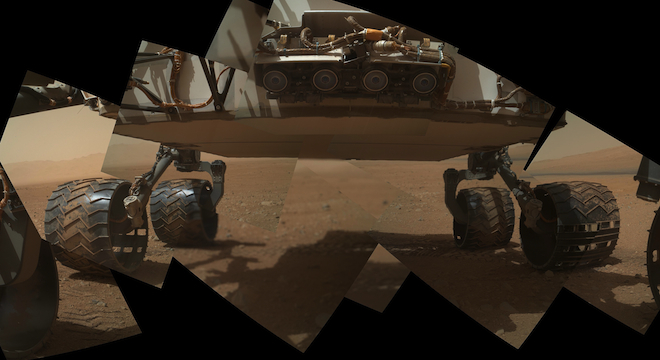NASA’s Mars Curiosity Rover had spent 37 Martian days (“sols”) on the Red Planet as of Wednesday and was one day away from becoming fully operational, NASA scientists said in a press conference back on Earth.
That’s because despite sending back incredible views of the Martian surface and its own car-sized form, the Curiosity rover was only undergoing preliminary checks during that entire five-week period.
Now, it’s poised to conclude those activities and have scientists clear all of its 10 instruments to begin their work on Mars — analyzing the Martian geology, chemistry and air for signs that the Red Planet ever had conditions conducive to supporting life at any point in its history.
As Jennifer Trosper, Curiosity’s mission manager at NASA’s Jet Propulsion Laboratory in Pasadena, California, explained the mission’s timeline so far in a conference call with reporters on Wednesday afternoon: “[Curiosity] is preparing to complete her absolute final day of characterization activities…Throughout every phase of checkout, Curiosity has performed almost flawlessly.”
Curiosity’s first four sols after nailing its landing on August 6, were dedicated to “deployments and communications checkouts,” Trosper noted, while the next four sols were dedicated to upgrading its flight software operating system — what Trosper and others at NASA have referred to as a “brain transplant,” the following four sols were dedicated to a “motor control flight software update,” followed by 13 sols of intermission, during which time Curiosity was driven to its present location some 358 feet from its landing site in the direction of an area of diverse rock formations, and consequently of interest to NASA scientists, known as “Glenelg.”
Following that, there were 7 sols during which time the Curiosity rover’s robotic, 7-foot-long arm was tested. Somewhere along the way, NASA scientists were also able to test out the rover’s military-grade rock-vaporizing laser, which is designed to turn rocks into dust that the rover’s instruments can better analyze.
Overall, the rover’s checkout activities took just one day longer than NASA had originally planned, 36 sols, which Trosper said was remarkable given that previous Mars rover and lander missions had suffered far greater delays due to a variety of unforeseen factors and glitches.
Trosper and her colleagues Ralf Gellert, principal investigator of Curiosity’s X-ray spectrometer instrument, and Ken Edgett, principal investigator of the rover’s Mars Hand Lens Imager (MAHLI), also took turns describing a new batch of highly detailed photos taken by the rover of itself and its surrounds.
In the first of the new images, an animated GIF, the rover’s mast-mounted camera, or Mastcam, captured the motion of the lids opening and closing on its Sample Analysis at Mars (SAM) instrument, which take up more than half the rover’s body and will be used to “search for compounds of the element carbon, including methane, that are associated with life,” once NASA dumps rock and soil samples into the holes.

Another pair of color images taken by the Mastcam show, up-close, the Alpha Particle X-Ray Spectrometer (APXS) instrument and the MAHLI instrument, respectively. Both of those instruments are located on the end of the rover’s 7-foot-long arm, one on each side. In the photos, the arm is retracted toward the rover’s body.


The images were important because they were able to show that the instruments hadn’t been damaged or covered in dust during the rover’s landing or journey across Mars so far.
The MAHLI instrument, modeled after the hand lenses used by human geologists on Earth, is designed to provide “close-up views of the minerals, textures, and structures in martian rocks and the surface layer of rocky debris and dust.”
The APXS instrument, by contrast, is designed to study the chemical composition of rocks and soils, identifying how much of what type of each chemical is found within samples. Already, the instrument has returned results from its test analyses of a target of “basaltic rock surrounded by a nickel plate” that was sent up on the rover, returning the following chart of the constituent elements:

Meanwhile, the MAHLI instrument was able to provide an insanely close-up view of another calibration target sent up on the rover, a 1909 Lincoln penny, the first run of pennies of the familiar type.

The view shows specs of Martian dust on the penny, including one “under Abraham Lincoln’s ear” that measures “about 0.008 inches (0.2 millimeters) across,” according to NASA, and another below the first of the “9s,” which measures about 0.004 inches (0.1 millimeters) across.
Another view from the MAHLI camera, taken when the robotic arm was extended underneath the rover’s body, or the “dog’s eye view,” in the words of NASA’s Edgett, show three of the rover’s six total wheels, each 20-inches in diameter:

The view is a composite of several images, the sum of which were captured during a “belly check” and which were later stitched together into a panorama, visible here.
After it completes its final checkout procedures, NASA plans to continue driving the rover until it finds a suitable rock sample to begin conducting tests, and eventually drilling into the Martian surface, although Trosper noted this was probably over a month away.
Before that, NASA will use the Mastcam to take still images and even video of the transit of Mars’ two moons, Phobos and Deimos, as they pass across the Sun, from the point-of-view of an observer on Mars.
The eventual goal of the Mars Curiosity Mission over its 23-month official planned operational life is to scale partway up a nearby Martian mountain, Mount Sharp, a 3.4-high incline that can be clearly seen in the image from underneath the rover’s body.






